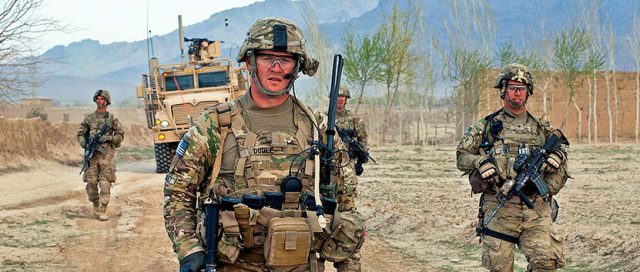The decisions that the Department of Defense made about its "radios of the future" more than 20 years ago are still having an impact on the communications gear the military services purchase today. The Joint Tactical Radio System program may have ended, but it left behind a legacy that the US Army is now trying to get away from—while still holding fast to parts of JTRS' framework.
JTRS, as Ars reported in 2012, was DOD's quest to build the perfect set of communications gear based on software-defined radio (SDR) technology. SDR was in its infancy in the mid-1990s, but the Joint Program Office JTRS (the organization driving the DOD-wide program) was convinced that investing early would pay off with cheaper hardware in the longterm, and the government-owned software (a sort of closed open source, with a library available to all vendors) would prevent lock-in with a limited set of contractors.CORBA style
JPEO JTRS is gone, but its software lives on. The Joint Tactical Networking Center (JTNC) has taken over management of the Software Communications Architecture, the application framework and POSIX-based real-time operating system that powers all the software-defined radios birthed from JTRS-descendant communications gear, along with libraries for the various mission-specific "waveforms" used by different radios. SCA provides an interface for software to manipulate the field-programmable gate arrays (FPGAs) in radio hardware to reconfigure how they function. And until recently, those interfaces required radio developers to use the Common Object Request Broker Architecture (CORBA) to access them.
CORBA was introduced in the 1990s as an answer to cross-platform development woes; DOD required CORBA and C++ be used in radio development because it wanted code portability. It didn't get it, partly because CORBA is complex and messy, especially as it was implemented in SCA. And even if the code was easily portable between radios (which it is not), changing radios from one waveform to another requires more than a software update—it requires a hardware swap-out in most cases.
In February, JTNC released SCA 4.1, a new iteration of SCA that finally drops CORBA. This could be good news for future SCA-based projects in terms of software development costs. And the Army needs all the good news it can get when it comes to communications.
Distress signals

Last September, Army officials announced that they were going to put the brakes on the Warfighter Information Network-Tactical communications system, the communications gear that acts as the Army's battlefield network backbone, after spending $6 billion so far on WIN-T's development. That did not go over well with Congress. But Army officials are concerned that the system, which is largely based on 10-year-old software, is not resilient enough to deal with jamming or even hacking by a technologically advanced adversary.
Then there's the Army's Handheld Manpack and Small Form Fit (HMS) radio program. These radios, used in the field by infantry, have been a headache for the Army for much of the last decade. Years behind schedule and way over budget, HMS radios were pushed out without full testing, using a "low-rate" production to get them fielded for three years before their contracts were even finally awarded.
The smallest of them, the handheld Rifleman Radio, is supposed to be the infantryman's data link to the wider Army network. The 5W radio uses JTRS' Soldier Radio Waveform, a digital communications format that works on UHF and L-band frequencies. But SRW is only used by soldiers on the ground; to communicate back up the chain of command and with supporting aircraft, the Rifleman Radio has to be relayed by a bigger Manpack (as in, backpack-sized) radio or by a vehicle-mounted radio. (A program for vehicle-mounted radios, the Ground Mobile Radio, crashed and burned in 2012.) And on a good day, under ideal conditions, the Rifleman Radio has a range of about 2km. And even with the Manpack along as a router, there were significant problems. Manpack Radio garbled digital voice communications, particularly when relaying to helicopters and other close air support.
Both Rifleman Radio and Manpack Radio were identified as having major problems during testing in 2014. But the Army had already started "low rate" (and by translation, higher cost) acquisition of the Rifleman and Manpack radios in 2012 while evaluations were underway. That "low rate" ended up not being so low: more than 21,000 Rifleman Radios were purchased before the contract for full production was awarded in 2015 because of the demand for radios for the ongoing wars in Iraq and Afghanistan.
-
A DOD Inspector General report in 2015 found many [redacted] things wrong with Rifleman Radio...
-
and quite a few with Manpack.
The final contract for Rifleman Radios, awarded to Thales and Harris, was for up to $3.9 billion to deliver 193,276 more radios. That amounts to around $20,000 per radio, including accessories and support; in 2014, the military expected the Rifleman Radio to cost about $5,600 per unit. The Manpack radios were expected in 2014 to cost about $72,000; the actual line item for Manpacks under the 2017 budget was $114.9 million for 1,459 radios; that's nearly $78,000 and does not include the maintenance, accessories, and services. That's not exactly the kind of cost savings one would expect from a commodity, standards-based system.
The Army is still trying to fill the gaps left by the two radios. Last month, the Army kicked off a $4 billion procurement program for the Leader Radio, a two-channel handheld radio based on the SRW waveform as well as the aged SINCGARS waveform used to communicate with aircraft, despite protests that the Army was excluding cheaper and more effective options based on other technologies.
Listing image by US Army
reader comments
108